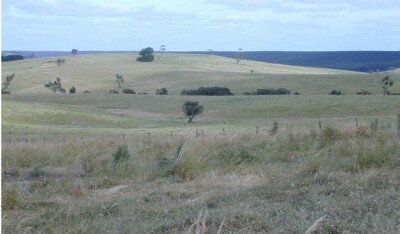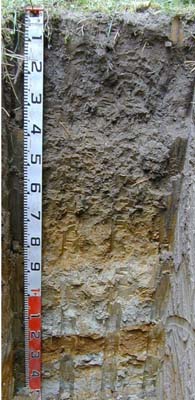ASH98 (plot 3)
| Site: ASH98 (Plot 3) | Land Unit: Digby |
 |
|
Site Description:
| Geology: Cretaceous non-marine sandstone | Landform pattern: Undulating plain |
| Internal drainage: Imperfectly drained |
Soil Profile Morphology
| A11 | 0-20 cm | Very dark greyish brown (10YR3/2) clay loam; weak polyhedral structure (20-50 mm); firm consistence when dry; common very fine macropores; areal porosity 0.1%; many medium roots; gradual and smooth transition to: |  |
| A12 | 20-40 cm | Dark brown (10YR3/3) clay loam; weak polyhedral structure (20-50 mm) parting to weak granular structure (10-20 mm); firm consistence when moderately moist; common very fine macropores; areal porosity 0.1%; few fine roots; clear and smooth transition to: | |
| Subsoil | |||
| B1 | 40-50 cm | Dark brown (10YR3/3) with common medium faint brownish yellow (10YR6/8) mottles, light clay; weak angular blocky structure (50-100 mm) parting to weak angular blocky structure (10-20 mm); firm consistence when moderately moist; few very fine macropores; areal porosity 0.05%; few fine roots; gradual and smooth transition to: | |
| B21 | 50-70 cm | Yellowish brown (10YR5/4) with many medium faint very dark greyish brown (10YR3/2) mottles, medium clay; weak angular blocky structure (50-100 mm); firm consistence when moderately moist; few very fine macropores; areal porosity 0.03%; few fine roots; clear and smooth transition to: | |
| B22 | 70-90 cm | Strong brown (7.5YR5/6) with many medium faint reddish yellow (7.5YR6/8) and red (2.5YR4/8) mottles, medium clay; weak subangular blocky structure (50-100 mm); firm consistence when moderately moist; common very fine macropores; areal porosity 0.1%; few fine roots; clear and smooth transition to: | |
| B3 | 90-115 cm | Light grey (10YR7/2) with few medium distinct brownish yellow (10YR6/8) mottles, medium clay; weak subangular blocky structure (20-50 mm) parting to weak subangular blocky structure (10-20 mm); firm consistence when moderately moist; common very fine macropores; areal porosity 0.1%; few fine roots; sharp and smooth transition to: | |
| C1 | 115-130 cm | Strong brown (7.5YR4/6), clayey sand; single grain structure; very weak consistence when moderately moist; few very fine macropores; areal porosity 0.05%; few very fine roots; sharp and smooth transition to: | |
| C2 | 130-150 cm | White (10YR8/1), silty clay; massive structure; weak consistence when moderately moist; few very fine macropores; areal porosity 0.05%; no roots observed. | |
| 150-350 cm | Medium to heavy grey clays, live roots observed to 300 cm along remnant root channels. | ||
| 350-390 cm | Purple/black Miocene mudstones with plant remains (carbonaceous). | ||
Notes: The Mudstone layer does not appear to offer a large water holding capacity.
Sampled by: Ian Sargeant, Paul Feikema and Martin Clark (6 December 2000)


